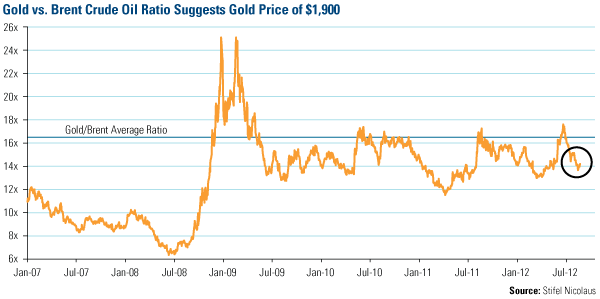Gold Market Radar (August 27, 2012)

For the week, spot gold closed at $1,670.55, up $54.50 per ounce, or 3.37 percent. Gold stocks, as measured by the NYSE Arca Gold Miners Index, rose 4.9 percent. The U.S. Trade-Weighted Dollar Index lost 1.18 percent for the week.
Strengths
- Gold rallied further this week, rising 3.37 percent to its highest level in 16 weeks. Significantly, gold closed above the technically critical 200-day moving average which may trigger both new long entries and short covering. PIMCO boosted its gold holdings to 11.5 percent of assets this week in its Commodity Real Return Fund, which comes on the heels of updates last week that George Soros and John Paulson each significantly raised their respective stakes in gold as well.
- Dovish comments in the FOMC minutes released this week suggested further possible stimulus may be warranted in the event of further weakness. Chairman Bernanke released a letter Friday stating that, “There is scope for further action by the Federal Reserve to ease financial conditions and strengthen the financial recovery.”
- Macquarie pointed out in a note this week that gold equities historically have outperformed the broader market when the commodity is moving higher over the 6-week period from August 13 to September 22. Morningstar had bullish comments as well, suggesting that gold equities’ relative underperformance to bullion is reversing, helped by cheap valuations. As we have mentioned before regarding the Love Trade, this seasonally strong period for gold correlates with anticipation of the Indian Diwali festival.
Weaknesses
- BHP Billiton delayed approval of its massive Olympic Dam expansion in Australia this week, prompting Australian Resources Minister Martin Ferguson to suggest that “the resources boom is over.” His statements contrast, however, with a report from the Reserve Bank of Australia which projected peak spending on resources sometime in 2013 or 2014. Weaker Chinese demand is by no means helping Australian resources and capital expenditure.
- This week, Mineweb reported that the Peruvian Prime Minister Juan Jimenez officially placed Newmont’s Minas Conga project on the back burner. While the controversial 5 billion dollar joint venture project with Peru’s Buenaventura and the World Bank has been on hold for about a year, its now-official collapse means Newmont will not achieve its stated annual projections of 7 million ounces of gold by 2017.
- We mentioned the unfortunate situation at Lonmin PLC last week, and continued strife in South Africa is a potential cause for concern. Commerzbank noted this week that, “At present, all the country’s mine producers are on increased alert … the possibility of the protests spilling over to other producers cannot be ruled out.”
Opportunities
- The gold-to-Brent crude oil ratio has historically averaged about 16.5x. According to this ratio and using an approximate Brent price of $115 per barrel, the price of gold should be roughly $1,900, on par with its all-time high close in 2011.
- Global monetary stimulus continues to be a relevant discussion. The Jackson Hole summit and Ben Bernanke’s speech are one week away, and with Europe unsolved, slightly more dovish Fed-speak, and weak Chinese data, the possibilities for global intervention remain high.
- While delayed capital expenditure and production difficulties can harm price action within particular equities, they offer more potential cash for shareholders in the form of dividends as well as limiting the supply of gold, thereby raising prices.
Threats
- A lack of additional stimulus measures poses something of a threat to gold; however, analysts at ANZ this week stated that the so-called “stimulus premium” in prices remains minor overall.
- Government regulation and uncertainty, as described, for instance, in the case of Newmont’s Minas Conga project in Peru, are threats.
- Finally, Europe and the euro remain a wildcard, and as the euro composes some 57 percent of the dollar index, events in Europe can and will affect the dollar (and gold) in unforeseeable ways.











